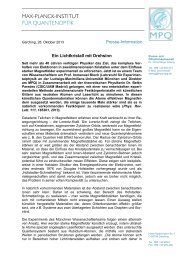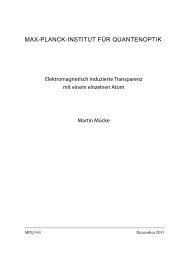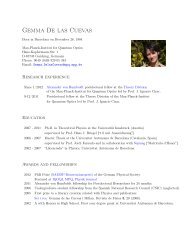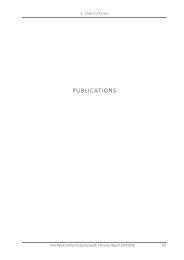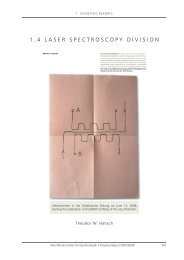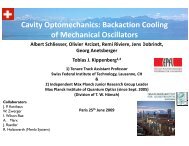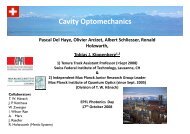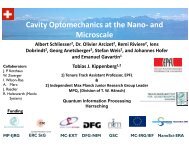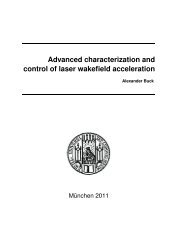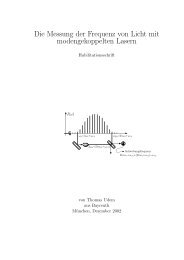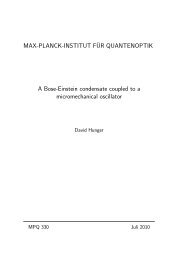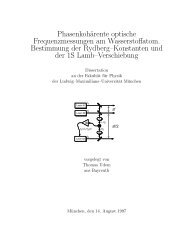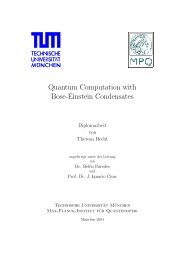Attosecond Control and Measurement: Lightwave Electronics
Attosecond Control and Measurement: Lightwave Electronics
Attosecond Control and Measurement: Lightwave Electronics
You also want an ePaper? Increase the reach of your titles
YUMPU automatically turns print PDFs into web optimized ePapers that Google loves.
1 . 3 AT T O S E C O N D A N D H I G H - F I E L D P H Y S I C S D I V I S I O N<br />
Figure 13: Gigaelectronvolt-scale laser wake field accelerator at MPQ. G: GRENOUILLE pulse diagnostics, C1-C5:<br />
cameras; D1, D2: diodes; L1, L2: scintillating screens; S: spectrometer; W: wedge; OAP: off-axis parabola; CAP:<br />
capillary waveguide. The inset shows the incoming laser focus at the capillary entrance.<br />
relativistic plasma, which shortens its duration into the<br />
required domain. Longer-than-optimal driver pulses<br />
compromise efficiency as well as reproducibility, <strong>and</strong><br />
result in copious amounts of low-energy electrons<br />
accompanying the mono-energetic emission with an<br />
exponentially-decaying spectrum, forming a “thermal”<br />
background. By using the multi-terawatt, sub-10-fs<br />
pulses from LWS-10, Karl Schmid, Laszlo Veisz <strong>and</strong><br />
coworkers, in close cooperation with Ulrich Schramm,<br />
Dieter Habs <strong>and</strong> collaborators from the Univ. Düsseldorf<br />
have recently demonstrated the first electron accelerator<br />
based on high-density plasma waves driven with<br />
laser pulses that fit in one half of the plasma period<br />
(Figure 11) [14]. Direct “impulsive” excitation of the<br />
plasma wave permits mono-energetic electron<br />
acceleration virtually free from a thermal background<br />
for the first time. In our experiments, 5-terawatt, 8femtosecond<br />
laser pulses yield electron bunches up to<br />
energies of 25 MeV (Figure 12). The flux of low-energy<br />
electrons dramatically reduced as compared to earlier<br />
experiments also manifests itself in a strongly-reduced<br />
secondary radiation emerging from the accelerator <strong>and</strong><br />
offers the potential for enhancing efficiency <strong>and</strong> stability<br />
with more intense driver pulses.<br />
The electron energy can be further boosted by laser-driven<br />
plasma-wake-field acceleration (LWFA) in a discharge<br />
capillary to the gigaelectronvolt range, as demonstrated<br />
by Wim Leemans <strong>and</strong> coworkers at Berkeley in 2006.<br />
Jens Osterhoff, Antonia Popp, Zsuzsanna Major, Stefan<br />
Karsch <strong>and</strong> coworkers, in close co-operation with Dieter<br />
Habs <strong>and</strong> his group, have recently also demonstrated<br />
LWFA to the GeV frontier from a discharge capillary<br />
waveguide provided by Simon Hooker from Oxford<br />
University by driving the accelerator with 0.75 J, 40fs,<br />
800-nm pulses from ATLAS, MPQ’s multiterawatt<br />
Ti:Sa laser, see Figure 13 [12].<br />
Quasi-monoenergetic electron beams with energies as<br />
high as 500 MeV have been detected, with features<br />
reaching up to 1 GeV, albeit with large shot-to-shot<br />
fluctuations. The beam divergence <strong>and</strong> the pointing<br />
stability in this case are around or below 1 mrad <strong>and</strong><br />
8 mrad, respectively. These shot-to-shot electron-bunch<br />
parameter variations are greatly suppressed by utilizing<br />
the capillary as a gas-vessel without pre-ionization by an<br />
external electrical discharge. In this regime of operation<br />
quasi-monoenergetic electron beams of up to ~200<br />
MeV in energy have been observed (Figure 14). These<br />
beams emitted within a low-divergence cone of mrad<br />
FWHM display unprecedented shot-to-shot stability<br />
in energy (2.5% RMS), pointing (1.4 mrad RMS) <strong>and</strong><br />
charge (16% RMS) owing to a highly reproducible gasdensity<br />
profile within the interaction volume (Figure15)<br />
[13]. The excellent stability of bunch parameters affords<br />
promise for the potential ability of laser-accelerated<br />
electron bunches to meet the stringent criteria for<br />
seeding free electron lasers.<br />
INTENSE ATTOSECOND XUV/SXR PUlSES<br />
might allow triggering as well as probing ultrafast<br />
electron dynamics with attosecond pulses, i.e.<br />
attosecond XUV-pump/XUV-probe spectroscopy,<br />
which has not been possible so far. Relativistic laserplasma<br />
interactions have been identified as a promising<br />
approach to achieving this goal. Recent experiments<br />
confirmed that relativistically-driven overdense plasmas<br />
are able to convert infrared laser light into harmonic<br />
XUV radiation with unparalleled efficiency <strong>and</strong> that the<br />
generation technique is scalable towards hard X-rays.<br />
In a recent experiment (Figure 15) Yutaka Nomura,<br />
Rainer Hörlein, Sergey Rykovanov, George Tsakiris <strong>and</strong><br />
coworkers, in collaboration with the teams of Matt Zepf<br />
from Belfast <strong>and</strong> Dimitris Charalambidis from Heraklion,<br />
have recently succeeded in obtaining conclusive<br />
experimental evidence for the phases of the XUV<br />
harmonics emanating from the interaction that they are<br />
144 Max-Planck-Institut für Quantenoptik • Progress Report 2007/2008



